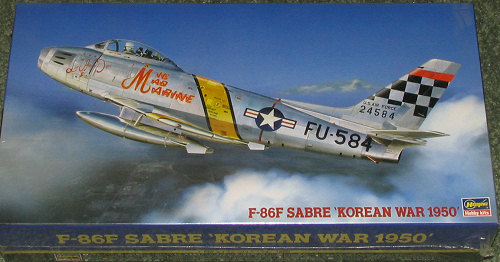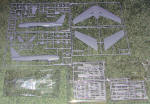
| KIT: | Hasegawa 1/48 F-86F Sabre "Korean War 1950" |
| KIT #: | 07082 (Pt122) |
| PRICE: | 3200 yen |
| DECALS: | Two options |
| REVIEWER: | Scott Van Aken |
| NOTES: | 1998 boxing |

| HISTORY |
The F-86 entered service with the United States Air Force in 1949, joining the 1st Fighter Wing's 94th Fighter Squadron "Hat-in-the-Ring" and became the primary air-to-air jet fighter used in the Korean War. With the introduction of the Soviet MiG-15 into air combat in November, 1950, in which it out-performed all aircraft then assigned to the United Nations, three squadrons of F-86s were rushed to the Far East in December. The F-86 could out turn and out dive the Mig-15, but the MiG-15 was slightly superior to the F-86 in ceiling, acceleration, rate of climb, and zoom (until the introduction of the F-86F in 1953); and flown from bases in Manchuria by Soviet VVS pilots, was pitted against two squadrons of the 4th Fighter-Interceptor Wing forward-based at K-14, Kimpo, Korea. The first Mig-15 shot down by a Sabre was by a pilot of No. 335 Fighter Interception Squadron, Flight Lt John Nicholls RAF.
Superior US pilot training in comparison to that of North Koreans and the Chinese accounted for much of the F-86's success in achieving air superiority during nearly all of the hostilities. F-86 pilots also achieved a favorable kill ratio even over the Soviet piloted Mig-15s. Soviets piloted the majority of Mig-15s that fought in Korea, while inferior North Korean and Chinese pilots piloted the rest of the Mig-15s. The Soviets and their allies periodically contested air superiority in MiG Alley, a hotbed for air-to-air combat near the mouth of the Yalu River (the boundary between Korea and China). Some sources attributed the F-86E's all-moving tailplane to giving the Sabre a decisive advantage over the MiG-15. Far greater emphasis has been given to the training, aggressiveness and experience of the F-86 pilots. Despite rules-of-engagement to the contrary, F-86 units frequently initiated combat over MiG bases in the Manchurian "sanctuary".
Review of archived and previously classified documents released after the fall of the Soviet Union in 1991 disputes the numbers of claims by U.S. pilots, stating that the VVS lost only 345 MiGs. In turn the Soviets claimed to have shot down more than 1,300 U.N. aircraft including more than 650 Sabres. However, USAF records revealed that there were only about 660 Sabres deployed to the Korean theater in the entire war. This fact makes the Soviet claims highly dubious. USAF records also show 224 F-86s lost to all causes, including non-combat. Many air engagements are corroborated by both sides, but with conflicting claims of kills.
The needs of combat operations balanced against the need to maintain an adequate force structure in Western Europe led to the conversion of the 51st Fighter-Interceptor Wing from the F-80 to the F-86 in December, 1951. Two fighter-bomber wings, the 8th and 18th, converted to the F-86F in the spring of 1953. 2 Squadron SAAF also distinguished itself flying F-86s in Korea as part of the 18 FBW.
I also found it especially interesting that the F-86 had the same thrust to weight ratio as the P-59 Airacomet. Yet the F-86F was 300 mph faster and I know which I'd have rather taken into combat.
| THE KIT |
 After years of having little more than the Monogram and later ESCI kit, 1/48 Sabre fans were blessed with two excellent kits in the Academy and Hasegawa F-86s. Both are worthy and many have difficulty choosing between the two of them. I've built theAcademy kit and found it to be quite nice, though not without some areas of concern.
After years of having little more than the Monogram and later ESCI kit, 1/48 Sabre fans were blessed with two excellent kits in the Academy and Hasegawa F-86s. Both are worthy and many have difficulty choosing between the two of them. I've built theAcademy kit and found it to be quite nice, though not without some areas of concern.
When Hasegawa first issued this kit, it was the extended wing F-86F-40 as used by the JASDF and it included markings for probably every Japanese unit that ever flew the plane. What most of us wanted was a shorter wing version as used in the Korean War and a bit later. Eventually, they came out with their 'US Air Force' boxing that had the shorter 6-3 wing (that is the one with the extended leading edges and no slats). This boxing is that kit, but with different decals.
However, Hasegawa did not change anything else besides the wings. Just to start out, there were no F-86F-30s in 1950 so the title should read "Korean War 1953". With this in mind, there are some items in the kit that are either not to be used or are not correct. For one, you won't use the Sidewinders and their racks. These were not, as far as I can tell, ever fitted to USAF Sabres, though the Japanese and other users of the F-86F-40 version had this capability. The![]() F-86F-30 was a fighter bombers so would have the option of inner pylons for bombs and those are not included. The last biggie is that the fuselage is for an F-86F-40. The biggest difference is the air scoop on the right fuselage behind the wing. This should be filled in. I'm thinking there are other small vents that are not appropriate, but I have no clear reference for them.
F-86F-30 was a fighter bombers so would have the option of inner pylons for bombs and those are not included. The last biggie is that the fuselage is for an F-86F-40. The biggest difference is the air scoop on the right fuselage behind the wing. This should be filled in. I'm thinking there are other small vents that are not appropriate, but I have no clear reference for them.
The molding is all that one expects from Hasegawa with crisply engraved panel lines. I did find that several parts suffered from mold faults in terms of sunken in areas. These are the gear doors and speed brakes, probably due to the thick detailing on the other side. The only part suffering from visible ejector pin marks is the seat bottom, where one is supposed to cover it with a pilot figure.
The cockpit is nicely detailed with raised instrument detail. A decal is provided for the main instrument panel and my experience with this fitting over the detail is quite positive. Side consoles will have to be painted as no decal is provided for them. Both intake and exhaust trunking is provided, along with a long seam on both sides that will be difficult to fill. Fortunately, Hasegawa also gives us intake and exhaust covers. I should also note that the speed brakes seem to have the proper droop, judging from the photos of the built kit on the instruction sheet. One thing you should note is that the fuel dump pipe should protrude down at about 45 degrees, not horizontal as shown on the kit build-up.
Other things provided are both Korean War and post war drop tank fins, a separate canop y and windscreen so you can show off the interior, as well as engine intake compressor and exhaust compressor faces should you wish to not use the covers. There is also room for nose weight around the intake trunking.
y and windscreen so you can show off the interior, as well as engine intake compressor and exhaust compressor faces should you wish to not use the covers. There is also room for nose weight around the intake trunking.
As mentioned, this is a reboxing with different decals. That being the case, you get the original boxing's instructions with an addendum sheet for the new decals. This sheet says nothing about not using the Sidewinders nor the early drop tank fins. The markings are for two 51 FIW aircraft. One is the box art aircraft of John Glenn's 'MiG Mad Marine', a very popular subject. The other is for the equally popular 'Mike's Bird'. Decals are very nicely done and appear to be quite thin. In addition to a full data suite, the yellow ID bands are also provided. My luck with these is not consistent, but perhaps these will work better than others I've tried.
One note is that the 6-3 wing was first factory installed on F-86F-30 52-4505 and so the kit wings are correct for both subjects (52-4584 and 52-4641). Some of the earlier F-86F-25s also had this wing factory installed starting with 51-13341. I'm not sure how many earlier Sabres, if any, were retrofitted before the war ended. Check your references to be sure.
| CONCLUSIONS |
So there you have it. Though going on or over 10 years since first released, it is still an excellent kit. Sure, unlike the Academy kit which is a Korean War era airframe, one will have to make some modifications to this one to backdate it, that does not mean it won't make into a fine model as long as one does their research.
| REFERENCES |
Thanks to me and my penchant for fine kits for this review sample.
November 2006
If you would like your product reviewed fairly and quickly by asite that has over 325,000 visitors a month, please contactme or see other details in the